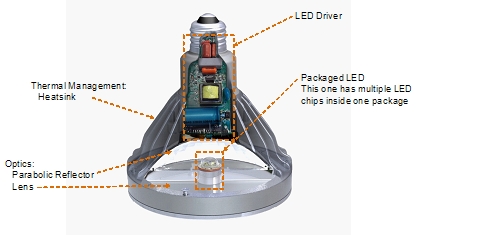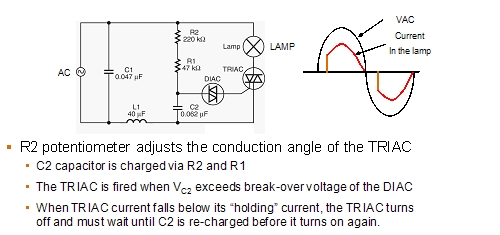Center topic: Exploring flicker-free dimming for LED lighting applications solution: LED (Light Emitting Diode), a solid-state semiconductor device that converts electricity directly into light. The heart of the LED is a semiconductor wafer. One end of the wafer is attached to a holder, one end is the negative pole, and the other end is connected to the positive pole of the power supply, so that the entire wafer is encapsulated by epoxy resin. The semiconductor wafer consists of two parts, one part is a P-type semiconductor, in which the hole dominates, and the other end is an N-type semiconductor, which is mainly electrons here. But when the two semiconductors are connected, a "PN junction" is formed between them. When a current is applied to the wafer through the wire, the electron is pushed to the P region, and the electrons are combined with the holes in the P region. Then it will emit energy in the form of photons, which is the principle of LED illumination. The wavelength of light determines the color of the light, which is determined by the formation of the PN junction material. The technology is maturing, and one of the signs is the introduction of a large number of LED lighting standards and specifications. Strict efficiency requirements have existed for quite some time and will continue to improve in the future. The brightness of the LED is inextricably related to the angle of illumination of the LED. The smaller the angle of the LED is, the higher the brightness is. There is no super bright or super bright, which is a trick for children. If it is a good quality LED, no matter which one. Everyone who produces LEDs has the same brightness, but the production process is different, and the service life is slightly different, because everyone uses the foreign LED chips. If it is 5mm LED 180 degree angle of white light, the brightness is only a few hundred MCD, if it is 15 degree angle brightness, it will go to more than 10,000 20,000 MCD brightness, the brightness difference is several tens of times, if it is used for lighting Use, in the outdoor is best to use high-power LED, the brightness is even higher, a single power has 1W, 3W, 5W, and some use a combination of multiple high power into a high-power LED, power to hundreds There are. Power factor is a very important factor because high power factor can reduce the loss of the distribution network. The most effective way to reduce the impact of electricity use on the environment is to reduce waste, so regulators around the world are further tightening their power factor specifications. An example of this is the Energy Star Solid State Lighting Energy Efficiency Specification (09/12/07), which states that the power factor (PF) of residential lighting products should be greater than 0.7 and the power factor (PF) of commercial lighting products should be greater than 0.9. Figure 1: LED bulb construction diagram LED bulb and luminaire manufacturers are responding to these requirements and naturally want their products to be as versatile as possible. Therefore, they are in great need of LED driver circuits compatible with various dimmers to achieve high efficiency and power factor of 0.9 or higher. The LED is made of a III-IV compound such as GaAs (gallium arsenide), GaP (gallium phosphide), GaAsP (phosphorus gallium arsenide) and the like, and its core is a PN junction. Therefore, it has the IN characteristic of a general PN junction, that is, forward conduction, reverse cutoff, and breakdown characteristics. In addition, it has luminescent properties under certain conditions. At the forward voltage, electrons are injected into the P region from the N region, and holes are injected into the N region from the P region. A part of the minority carriers (small children) entering the other area is combined with the majority carriers (multiple sub-) to emit light. Some people call the LED light source a long life light. It is a solid cold light source, epoxy resin package, and there is no loose part in the lamp body. There are no shortcomings such as filament light-emitting, heat deposition, light decay, etc. Under the proper current and voltage, the service life can reach 60,000 to 10 Ten thousand hours, more than 10 times longer than traditional light sources. Dimming controller The lighting controller operates in either line dimming or secondary side dimming. The simplest line dimming method is the leading edge thyristor controller. This is currently the most commonly used lighting control method, but unfortunately, the use of thyristor controllers to dim LED lights can cause a lot of problems. Flexible programmable control function can control the voltage limit of the buck, and the Switch lamp time can be set arbitrarily. The control mode is sometimes controlled, light control, manual control, remote control of the upper computer and automatic control according to the latitude and longitude of the place of use. Soft start, soft transition, soft shut-off function, prevent over-voltage and cold start large current impact on the luminaire, greatly reducing the damage rate of the luminaire. For sodium lamps, mercury lamps and other lamps with adjustable full-pressure preheating start-up time, the lamps can be fully preheated and smoothly transition to normal working conditions. It can realize all-night light and midnight light control, and has the function of step-down and current adjustment in the middle of the night, and the energy-saving effect is more ideal. The perfect restart function can automatically re-ignite the lamp when the load is faulty and the external power supply is over. The control mode is sometimes controlled, light control, manual control, remote control of the upper computer and automatic control of latitude and longitude according to the place of use (optional). The three-phase switch lamp time and output voltage can be adjusted independently, and can be connected to unbalanced and different types of loads. Programmable service mode for easy access to lighting system maintenance, maintenance and lamp replacement. A set of clocked normally open contacts is reserved for special control. The contact capacity is 7A/250VAC. The performance of thyristor controllers in incandescent lamps is impeccable, but there are various negative effects in LED lamps, including flicker, uneven illumination, audible noise, and flicker. To understand why, you must first understand how thyristor dimmers work. Figure 2: Front edge thyristor dimmer Dimming control is achieved by changing the phase angle of each half cycle of the thyristor conduction. The current in the filament of the bulb is closely related to the phase angle of the dimming signal, and the phase angle varies from 0° (near 0°) to 180°. This is the minimum load that the thyristor must maintain to remain conductive without the use of a gate drive. In order to maintain stable operation of the thyristor, the current cannot be zero, and the typical value of IH is between 8 mA and 40 mA. When driving an incandescent lamp, maintaining current is not a problem.
Controllers with isolated and non-isolated designs can perform power factor correction 
